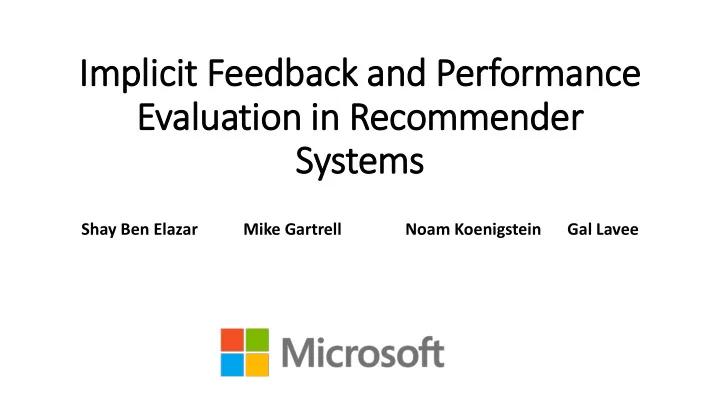

Im Implicit Feedback and Performance Evaluation in in Recommender Systems Shay Ben Elazar Mike Gartrell Noam Koenigstein Gal Lavee
Agenda • Intro Universal Store Recommendations • Extreme Classification with Matrix Factorization • Offline Evaluation Techniques • Online Evaluation • The Gap • Bridging The Gap…
Microsoft Universal Store Recommendations
Windows Store
Groove Music
Xbox
Extreme Classification with Matrix Factorization
History: Netflix Prize ... 4 5 2 ... 5 4 1 3 ... 4 3 4 1 ... 4 5 2 3 4
Two-class data – Extreme Classification ... 1 1 0 1 ... 0 1 1 0 ... 0 1 1 0 0 ... 0 0 0 1 1 0 1
One-class data ... 1 1 1 ... 1 1 ... 1 1 ... 1 1 1
Problem formulation M ≈ 10 – 500M nodes N ≈ 10K – 1M nodes ? ? ... ? ? Bipartite graph → We care about ? = p ( link )
Fully Bayesian model based on Variational Bayes optimization
Offline Evaluation Techniques
𝑆𝑁𝑇𝐹 - Root Mean Square Error RMSE is computed by averaging the square error over all user item pairs, 𝑣, 𝑗 ∈ ℛ 1 𝑆𝑁𝑇𝐹 = 𝑇𝐹 𝑣𝑗 ℛ 𝑣,𝑗 ∈ℛ
𝑥𝑆𝑁𝑇𝐹 - Weighted Root Mean Square Error This variant of RMSE is achieved by assigning each data point a weight, 𝑥 𝑣𝑗 , based on its importance. 1 𝑆𝑁𝑇𝐹 = 𝑥 𝑣𝑗 ⋅ 𝑇𝐹 𝑣𝑗 σ 𝑥 𝑣𝑗 𝑣,𝑗 ∈ℛ
Precision@ 𝑙 / Recall@ 𝑙 Ranking Induced by Ground Truth Algorithm 𝒍 = 𝟒 Positive Result 3 Positive Result 1 𝑞𝑠𝑓𝑑𝑗𝑡𝑗𝑝𝑜@𝑙 = 2 3 Negative Result Positive Result 2 𝑠𝑓𝑑𝑏𝑚𝑚@𝑙 = 2 3 Positive Result 3 Positive Result 1 Positive Result 2
Mean Average Precision We can plot precision as a function of recall Recall v Precision Ranking Induced by 100% Algorithm 90% 80% Positive Result 3 70% 60% Precision 50% Negative Result 40% Average Precision 30% 20% Positive Result 1 10% 0% 0% 33% 67% 100% Recall Positive Result 2
𝑂𝐸𝐷𝐻 – Normalized Discounted Cumulative Gain 1 The relevance is discounted by 𝛿 𝑗 = log 2 𝑗+1 and the sum @ k is normalized by its upper bound – the I𝐸𝐷𝐻 Ranking Induced by Algorithm 𝒍 = 𝟒 Ground Truth 1 5 Positive Result 3 𝐸𝐷𝐻@𝑙 = 𝑚𝑝 2 1 + 1 + 0 + 𝑚𝑝 2 3 + 1 = 3.5 Positive Result 1 5 3 1 Relevance: 5 I𝐸𝐷𝐻@𝑙 = 𝑚𝑝 2 1 + 1 + 𝑚𝑝 2 2 + 1 + 𝑚𝑝 2 3 + 1 = 7.39 Negative Result Positive Result 2 Relevance: 3 𝟒.𝟔 𝑶𝑬𝑫𝑯@𝒍 = 𝟖.𝟒𝟘 = 0.47 Positive Result 1 Positive Result 3 Relevance: 1 Positive Result 2
𝑁𝑄𝑆 - Mean Percentile Rank Sometimes there is only one “positive” items in the test set… Ranking Induced by Algorithm Ground Truth Positive Result 3 Negative Result Positive Result 1 Negative Result 𝒔𝒃𝒐𝒍 𝒋 = 𝟒 Positive Result 1 𝑵𝑸𝑺 = 𝟏. 𝟔 Positive Result 2 Negative Result
MPR in Xbox
Spearman’s Rho Coefficient In scenarios where we want to emphasize the full ranking we may compare the ranking of the algorithm to a reference ranking Ranking Induced by Ground Truth Algorithm Ranking 𝑠 1 − Ƹ 𝑠 1 = 1 − 3 Result 3 Result 1 Result 4 𝑠 2 − Ƹ 𝑠 2 = 2 − 4 Result 2 Result 3 𝑠 3 − Ƹ 𝑠 3 = 3 − 1 Result 1 Result 4 𝑠 4 − Ƹ 𝑠 4 = 4 − 2 Result 2
Ƹ Kendall’s Tau Coefficient In scenarios where we want to emphasize the full ranking we may compare the ranking of the algorithm to a reference ranking Same Order Ranking Induced by Ground Truth sign 𝑠 1 − 𝑠 2 ⋅ sign 𝑠 1 − Ƹ 𝑠 2 = 1 Algorithm Ranking Positive Result 3 Positive Result 1 Negative Result Positive Result 2 Positive Result 3 Positive Result 1 Negative Result Positive Result 2
Offline Techniques – Open Questions • How do we measure the importance/ relevance of the positive items? • Long tail items are more important. But how do we quantify? • How many items do we care to recommend? • Should the best item be the first item? • Maybe the best item should be in the middle? • What about diversity? • What about contextual effects? • What about items fatigue?
Online Experimentation
Online Experiments • Randomized controlled experiments • Measure KPIs (Key Performance Indicator) directly • Can compare several variants simultaneously • The ultimate evaluation technique!
Online Experiments in Xbox
Game Purchase Direct Purchases
Total Game Purchase Total Purchases
Experimentation Caveats • What KPIs to measure? • How long to run the experiment? • External factors may influence the results • Cannibalization is hard to account for • Expensive to implement • Can’t compare algorithms before “lighting up”
The Gap
Accuracy and Diversity Interactions
Characterizing The Offline / Online Evaluation Gap • Overemphasis of popular items • List recommendations (diversity, item position) • Freshness/ Fatigue • Contextual information is not fully utilized • Learning from historical data lets you predict the future. But what we really care about is changing the future!
Bridging The Gap
Mitigating Evaluation Techniques • Domain experts / focus groups • Internal user studies • Off-policy evaluation techniques
Off Policy Evaluation - Example 𝜌 𝑇 - The expected reward of a policy ℎ given data 𝑇 from a “logging 𝑊 ℎ policy” 𝜌 . 𝜌 𝑇 = 1 𝑠 ⋅ 𝕁 ℎ 𝑦 == 𝑏 𝑊 ℎ 𝑇 max ො 𝜌 𝑦 𝑏 , 𝜐 𝑦,𝑏,𝑠 ∈𝑇 where 𝑇 denotes the set of context-action-reward tuples available in the logs
Caveats of Off-policy Evaluation • Need to formulate everything in terms of a policy • Needs sufficient support • Becomes very difficult when your policies are time dependent
Thank you! We are looking for postdoc researchers to join us in Israel … Email: RecoRecruitmentEmail@microsoft.com
Recommend
More recommend